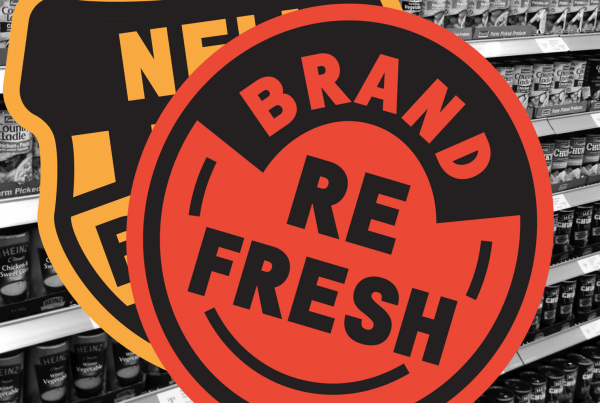“I think my client needs to update his brand,” one of our business contacts confided over coffee recently. “But I don’t know enough about design to put my finger on it. Do you have any tips?’
Actually, yes. We have so many, we can’t contain them within a conversational answer. That’s why we’ve written this lengthy roundup instead. It’s aimed at cluey professionals like you – the management consultants, business advisors, accountants, marketing strategists and others who aren’t designers, but know it’s time to steer their clients in the right direction.
Best of all, the principles of a meaningful brand refresh are not as elusive as you might think. If you’re already sensing something’s wrong, you’re probably right. After all, to quote Jeff Bezos, ‘Your brand is what other people say about you after you leave the room.’
Simply put, brand design is a form of communication: a tool for sending the right messages about your brand. Or your client’s brand. Or your employer’s brand.
Getting the basics right
First of all, let’s look at the basics of a brand identity. This is so much more than just a logo. It starts with the actual brand experience, from the swiping or tapping or other usage features, to the shopping carts, unboxing and after-sales support.
Then there are the visuals of your business, from the logo to wordmark, typefaces, palettes, graphic elements and photography. These should be consistent across every output: internal materials and external ones. There’s also voice: the way language reinforces the design, to project the business’ authority, warmth, guy or girl-next-doorness, sophistication or other defined value.
In short, the brand elements need to reflect a business’s peerless values, audience mindset and strategy. So before you embark on the brand refresh, make sure to first audit those brand foundations by considering its original strategy and whether this still applies.
With the brand audited and strategy reviewed, you can go through the checklist below to see if you can pick the main problem.
-
Doesn’t back vision or values
Even for the uninitiated, design has some fundamental cues that designers use and audiences subconsciously respond to.
The branding for a tech firm will have movement, energy, surprise. For an artisan food producer, it’ll have warmth, craft and earthiness.
Remember, we’re not just talking obvious areas like the logo and website. Look at every output. The thoughtful packaging from a premium retailer, for example, exudes brand values even in the nutty aroma of the organic inks used.
2. Looks like everyone else’s
Google any brand identities in your sector, and you’ll soon be scrolling pages and pages of clichéd visuals.
Business consultancy? You’ll probably see navy blue, arrows pointing upwards and lots of world globes. Wellbeing or care business? Expect natural greens, heart motifs, and hands cupped together like they’re nurturing something.
Worse than clichés, some company logos are an outright copy of some other brand’s – whether it’s an animal mascot, concentric circles or Everest-inspired peak. This happens all too often if the logo was created by an inexperienced or overseas-based designer.
Remember, your audience is smart. They deserve better. And while individual design elements have all been done before (an A-shaped wordmark; the colour blue; a block arrow), it’s how you weave it all together that creates a strikingly original end result.
Look at some of the world’s top design blogs (that’s right: go beyond Australia) and you’ll be blown away by the possibilities for your brand refresh. We’ve listed a couple of our faves at the end of this story
3. Lacks a distinct voice
Brand language reinforces the visual identity like nothing else, and helps explain why the branding is so simple, so slick or so hand-finished.
For example, Booktopia’s messaging is all about being an ‘Australian bookstore’ while Amazon’s is about diversity of choice (‘Everything from A to Z’). MailChimp and Hubspot’s voice emphasises being straight-talking and warm, while Campaign Monitor is a bit cooler – concise, empowering and with ‘positive simplicity’, in their words.
To develop a distinctive voice for your brand refresh, probe deep into your brand vision and values, and then wrap those pieces up in your brand personality.
4. Just uninspiring
Expanding on the theme of poor originality (above), some corporate visual identities are so bad they don’t even involve imitation. Just a PC font or two, jammed into a block shape or lozenge. Maybe a contrasting colour or line that only messes with the brand name, serving no purpose.
We often wonder who actually created these things. Was it the boss, mucking around one day on PowerPoint? Or maybe they paid someone $20 to design it?
The problem with uninspiring brands is that they eventually become part of the furniture. Why bother changing it, right? Like that house with cork flooring laid in 1985, or the sofa with grandpa’s butt-print permanently embossed.
To check the relevance of your branding, share your business materials with some trusted insiders. Ask them to describe it using three adjectives. Then match these against your actual brand values, and see if there’s a mismatch.
5. No visual system
Having a logo is just the start.
You’ll also need a visual system to support a huge range of materials, viewed on channels as diverse as social platforms, websites, high-gloss presentation files, outdoor billboards or anything else. A good graphic system will also support the needs of different users: those learning about your service for the first time, regulars engaging with it last thing at night, or potential buyers needing to watch your explainer video.
Sometimes, your logo can be brilliant and much-loved by stakeholders, so your brand refresh simply involves an update of these other visual assets.
The work to do this is worth it. A business owner we know was complaining recently about how long it had taken their (low-rent, overseas-based) designer to develop the graphic animations for their marketing videos.
We saw the problem immediately. They had a logo but no other graphic system, despite being a respected and decades-old consultancy. No wonder the resulting animations took five times longer than planned, involved much moaning and in-fighting, and still doesn’t look like it’s uniquely theirs.
6. Feels too dated
Imagine fitting out your new business premises with faxes, mailrooms or filing cabinets. Inconceivable, right?
The shape of business changes every half-decade. Equally, you should regularly check for design faux-pas that make your business look stale, such as drop-shadow typefaces, mirror-finish logos or the colour known as millennial pink.
Every era has its hallmark graphic elements. If you jump right on board with the latest crossed-oar logo or gradient graphic trend, chances are it’ll look dated within six months. Make sure that any on-trend styles are relevant, sparing and combined with more timeless elements.
If you’re still not sure how to direct your client or team, just Google any styles you suspect are either hot tickets, or on their way out. You’ll soon be scrolling pages and pages of evidence. Swoosh logos, retro fonts, starbursts, websites that play music… they’ve gone the way of the dodo.
7. Lacks something new
Even if your brand doesn’t look visibly dated (yet), when was the last time you gave fans something new to think about?
Technology lets brands do things that were unconceivable just a few years ago, and your brand refresh should include new ways you can reach out to clients. For example, today’s small-run print services allow you to use a different brand colour on each business card. Video has become affordable for all. Websites are increasingly viewed on mobile devices. Animation can enliven your materials through jiggling logos, GIFs and more.
Embrace these ideas, and update them often to stay relevant.
8. Too much jammed in
Clutter is the enemy of good design.
For example, a clash of mismatched stock photo styles: sleek business people in icy greys one minute, and warm golden coffees on a wooden table the next. Or multiple fonts: for headers, subheads, breakouts and body copy. Or overbearing finishes: breakouts, underlines, backdrops.
Even some of the video backgrounds for the latest crop of websites are overdone. Background motion graphics should be a gentle jiggle on the screen, not epic cinematography. Otherwise you’ll start to detract from the main message and make your viewer feel carsick.
9. Not enough added in
Don’t get us wrong; minimalism is a core feature of good design. We haven’t yet had a client wanting a complicated brand identity – most aspire to the super-sleekness of Apple, Uber or Xero.
Yet many startups have just that clean minimal logo, and very little else to get people inspired. And for corporations with a lot to talk about – technical specs, news, people, projects, products and more – you can’t expect the logo and palette alone to navigate users to the sections they want. This is what we touched on in Point 5 above.
Your brand refresh will need a just-right degree of variation to reinforce your navigational elements, information hierarchies, product categories, calls to action, warm customer messages and other parts of your physical or digital materials. You’ll need a photography concept so that all other imagery sings from the same songbook. You’ll need an actual team photo (not just sleek, square-jawed stock photo people). All that put together forms the tapestry of a meaningful brand.
So as you can see, good brand design draws on a certain degree of common sense principles. It also takes an experienced eye, a reliable support team and an understanding of key terms to get it right.
This understanding is best nurtured by reading some of the world’s great design blogs. (For the record, some of our favourites are BP&O, Identity Designed, the Brand New blog of Under Consideration and Logo Lounge, especially its very entertaining annual wrap on logo trends). Make sure also to follow design companies you like on social media.
Staying up to date with design and marketing trends will hone your ability to know what the world’s best work looks like. Then you can make the right design decisions with your creative team, and guide your company to the right outcome.



